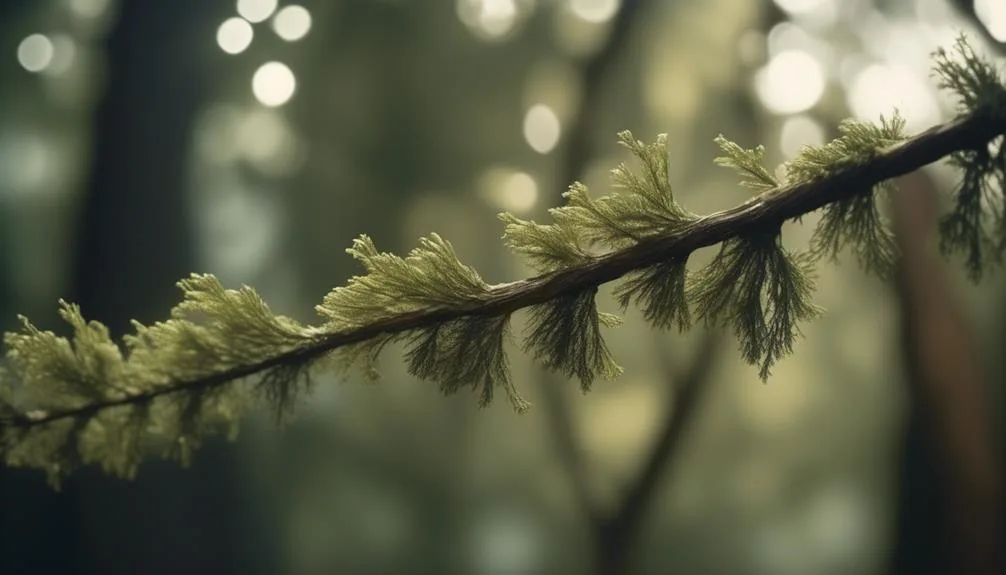Are your cedar trees not looking their best? Concerned about fungal infections? Understanding the signs and symptoms is key for effective diagnosis and treatment.
Identifying the culprit fungus quickly is crucial. In this discussion, we'll explore diagnostic methods and treatment options for cedar tree fungal infections, providing you with the knowledge and tools to address these issues.
Understanding Cedar Tree Fungal Infections
If you've ever wondered how cedar trees become susceptible to fungal infections, it's important to understand the environmental factors that contribute to this process.
Fungal spore dispersal plays a crucial role in the initiation of cedar tree fungal infections. These microscopic spores are carried by the wind or insects and can land on the tree's vulnerable areas, such as wounds or openings in the bark.
Additionally, soil moisture levels significantly impact the susceptibility of cedar trees to fungal infections. Excessive moisture creates favorable conditions for fungal growth, weakening the tree's defenses and making it more prone to infection.
Recognizing Symptoms and Signs
Recognizing symptoms and signs of cedar tree fungal infections is crucial for early intervention and effective treatment.
Visual cues such as discoloration of leaves, wilting, and unusual growths on the bark are common indicators of a fungal infection. Keep an eye out for any changes in the overall appearance of the cedar tree, including the presence of powdery or fuzzy substances on the branches or trunk.
Early detection techniques involve regularly inspecting the tree for any abnormal developments, especially after periods of heavy rain or high humidity. Additionally, pay attention to any unusual odors emanating from the tree, as some fungal infections can cause a distinct musty or rotten smell.
Diagnostic Methods for Identifying Fungi
When diagnosing fungal infections in cedar trees, it is essential to employ reliable diagnostic methods for accurately identifying the specific fungi involved. Two primary diagnostic methods for identifying fungi in cedar trees are microscopic examination and DNA sequencing. Microscopic examination involves studying the structure and characteristics of the fungal spores and mycelium under a microscope, allowing for the identification of specific fungal species based on their unique features. DNA sequencing, on the other hand, involves analyzing the genetic material of the fungi to determine their species and genetic relationships. Below is a table summarizing these diagnostic methods:
| Diagnostic Method | Description |
|---|---|
| Microscopic Examination | Involves studying fungal spores and mycelium under a microscope. |
| DNA Sequencing | Involves analyzing the genetic material of the fungi. |
These methods are crucial for accurately diagnosing and treating fungal infections in cedar trees.
Effective Treatment Options
To effectively address cedar tree fungal infections identified through reliable diagnostic methods, it's crucial to explore and implement a range of effective treatment options.
Natural remedies such as neem oil, garlic spray, or copper fungicides can be used to control fungal growth. Neem oil acts as a natural fungicide, while garlic spray and copper fungicides can help prevent the spread of infection.
Additionally, medication options like fungicidal sprays containing chlorothalonil or propiconazole can effectively treat cedar tree fungal infections. These sprays should be applied as directed on the product label, typically every 7-14 days depending on the severity of the infection.
It's important to carefully follow the instructions for any treatment to ensure its effectiveness and minimize any potential harm to the cedar tree or the surrounding environment.
Preventive Measures for Future Protection
Implementing preventive measures is essential to protect cedar trees from future fungal infections.
To ensure the future maintenance of healthy cedar trees, it's crucial to take proactive steps to prevent the spread of fungal spores.
Begin by promoting good air circulation around the trees, as this can help reduce humidity levels and limit the potential for fungal growth.
Additionally, regular pruning to remove dead or diseased branches can minimize the risk of infection.
Consider applying a fungicidal treatment as a preventative measure, especially in areas where fungal infections have been prevalent in the past.
Lastly, maintaining overall tree health through proper watering, fertilization, and soil management can strengthen the cedar trees' natural defenses against fungal attacks.
Conclusion
Involving a professional arborist is essential for diagnosing and treating cedar tree fungal infections. By taking proactive steps and implementing effective treatments, you can safeguard your cedar trees' health for years to come.
Your trees will thank you for it.

My interest in trees started when I first saw the giant sequoias in Yosemite.
I was a teenager then, and I remember thinking, “I need to learn more about this.”
That moment stuck with me.
A few years later, I went on to study forestry at Michigan Tech.
Since graduating, I’ve worked in a mix of hands-on tree care and community education.
I’ve spent over ten years helping people understand how to plant, maintain, and protect the trees in their neighborhoods.
I don’t see trees as just part of the landscape.
They are living things that make a real difference in our daily lives.
